I rediscovered my love of art when I was 38 years old. The spark was a class facilitated by Erica Ross called “Create Your Own Healing Deck” at Sheena’s Place in 2007. By the end of the course, I had created more than a dozen cards that contained encouraging words and images to address my struggles with emotional eating.
My collages were exhibited at Sheena’s Annual Art Show (2007 and 2008), and I continued to attend classes there, including Erica’s “Dance Our Way Home” and Ellen Jaffe’s “Writing Your Way.” The prose-poem that accompanies Ruined Barn in this exhibit emerged from a writing exercise in which Ellen asked us to imagine ourselves as a landscape. Barn Memory wrote itself in a white-water rush, a lament for past and current losses:
I am a ruined barn, empty but smelling of ancient hay. I sit in a lost valley, no longer a shelter nor part of a living farm. I used to be warmer, to glow orange from lanterns on February mornings, to retain animal heat. Now my shadows fill in their outlines, random headlight baths from the highway my only relief.
All my sounds are whispers and echoes now, where once I heard grunts, shouts, whinnies, cries of pain and hunger. It’s so quiet now. Ruin is quiet . . . . I miss being whole. I miss being real. I miss the animals I used to protect.

Barn Memory and the collage that illustrates it are the “grief-seeds” (Rumi) at the root of Maps of Loss: Rivers, Ruins, and Grief. Even though I made the encaustic painting Inner Map: Non-Political three years after I wrote the barn piece, there is a living connection between these two inner landscapes and the eight other works of art you see at Richview Library today.
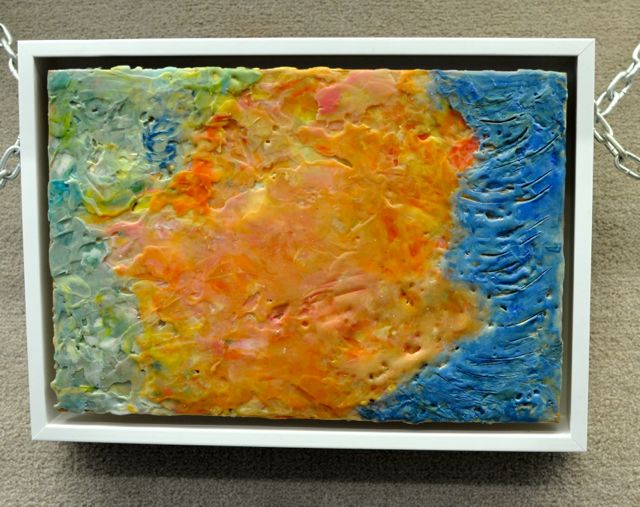
Maps of Loss has helped me articulate grief and map it visually, divining underground rivers of emotion that I had not detected beneath the surface. This personal excavation has revealed unexpected artifacts, including a Trippy Pier to Nowhere, a Heron and Ladder, a woman alone in a purple bed, and rivers (Tidal River and Encaustic River Beast). These unearthed souvenirs of my psyche speak to mystery, solitude, and a sense of moorings washed away.
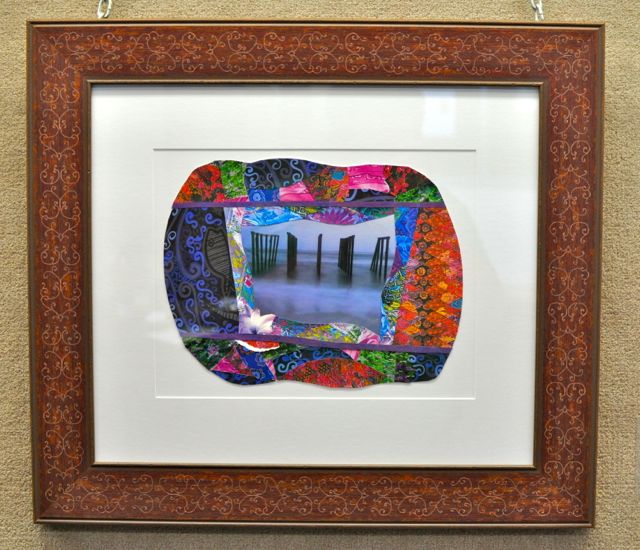
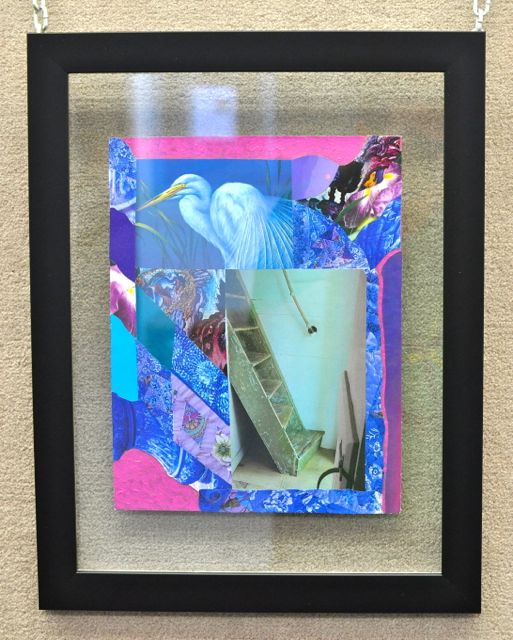

In July 2010, my childhood friend Jenny died of cancer at age 41. On the day she died, I went to the Picture Collection at the Toronto Reference Library to look for meadows and the flowers she loved. I felt connected to Jenny when I pored over a folder containing peaceful scenes from nature. And when I memorialized my friend in Jenny’s Purple Iris, I used her favorite flower to create an organic gown, a vision of peace in her body after the suffering ended.

In the fall of 2010, I distracted myself with a continuing education course in encaustic painting at the Ontario College of Art and Design. I learned how to melt wax to create tactile pieces that smelled of beeswax, and the three encaustic paintings in Maps of Loss come from my time at OCAD. Two of these pieces contain rivers, which reflects one of my earliest influences. Having grown up near the banks of the Missouri River, rivers mean home, time passing, movement, and change. They also represent uncensored feelings: unpredictable, fierce, embodying invisible currents and the wild mystery of eddies.

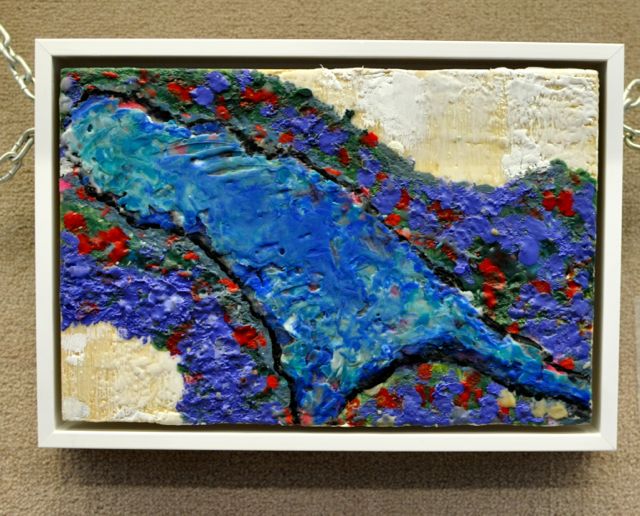
The remaining two pieces, Lenin;s Mosaic and When Ruins Swoon, flow back to the beginning, connecting me to Ruined Barn. The central photographs in both collages depict ruined houses in the former Soviet Union that have partially returned to nature after nuclear disaster.
These images of Cold War wreckage haunt me because my father’s health was also ruined by this war. When he was in the United States Navy in the late 1950’s, he witnessed atomic blasts in the Pacific Ocean as part of a testing program during the nuclear arms race. From his post on Midway Island, he and his naval comrades watched the blasts without any protective gear, and the cancers he later developed correspond to cancers caused by radiation exposure. He died in 1995 at the age of 58. (Jenny promised to give him a hug for me).

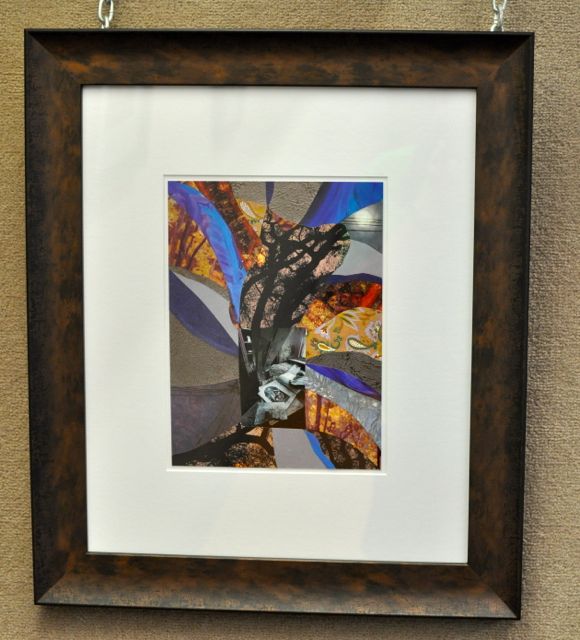
A ruined barn, house, or room can symbolize a body stricken by illness, once vital but now a husk. Ruins also represent loss, mortality, and history; they are relics of forgotten worlds. Like rivers, they testify to the inescapable passage of time. Like maps, they locate a particular loss in a specific time and place. They are both tangible and abstract, accessible and remote.
To add an element of hope to the ruins, I have enveloped them in mosaics that suggest new colour and growth. Thank you for taking part in my own artistic growth by viewing Maps of Loss. Your presence helps me answer Rumi’s question: “Where will you plant your grief-seeds?” (Illuminated Rumi, translation by Coleman Barks)

6 replies on “Exhibit Background for “Maps of Loss: Rivers, Ruins, and Grief” (Richview Library, September 2011)”
fantastic. helpful. thank you.
I’m so happy that the post was helpful to you, Michele. Thank you so much for your comment.
Dear Catherine,
Really happy to have seen these. It’s looks like a wonderful exhibit, and I’m sorry I missed it (thanks for the heads-up before I bicycled out there!!). I do think there’s a lot of grief rising to the surface in the world these days. To me this feels very much like a time of endings as well as new beginnings. In fact it does feel like the ending of an entire age or epoch. But there’s personal grieving for us to do, and for me to do, as part of that.
Dear Arnold,
Your reflective and insightful comment has nourished my spirit! Thank you! One of my hopes for the exhibit was that it would have a much broader meaning than my personal grief. I so appreciate your time and attention directed towards the exhibit. Peace, Catherine
Turning grief into a creative expression of art – a very healing thing to do, that not many people think of. Thanks for sharing this.
Many many thanks to you, Anuradha, for your thoughtful and sensitive comment.